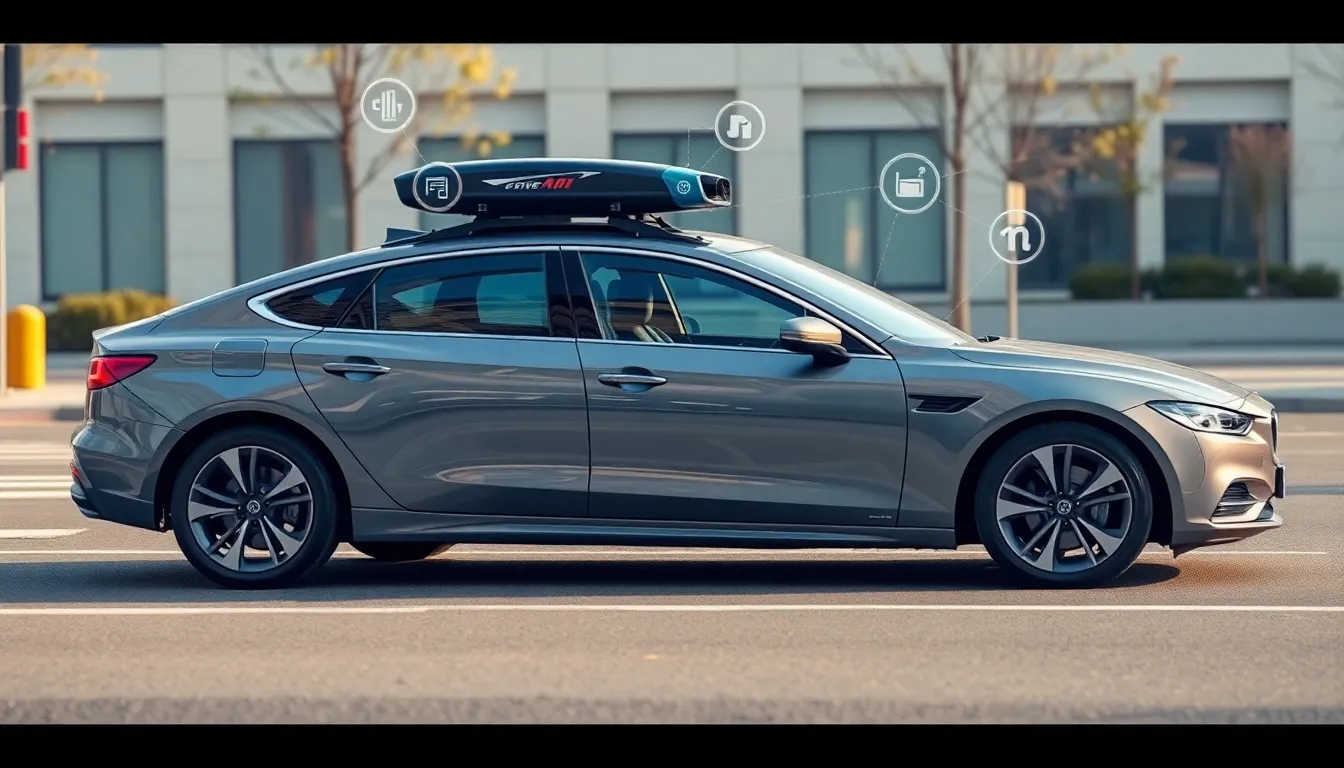Picture this: you hop into your car, and it greets you like an old friend. The Internet of Things (IoT) is revolutionizing the automotive world, turning ordinary vehicles into smart companions that anticipate your needs. From adjusting the temperature to suggesting the fastest route, these tech-savvy cars are here to make every drive a breeze.
Table of Contents
ToggleOverview of Internet of Things Automotive
Automakers increasingly integrate the Internet of Things (IoT) into their vehicles, creating smarter and more connected transportation solutions. Enhanced connectivity enables vehicles to communicate with external devices and other vehicles, improving safety and efficiency. Real-time data exchange provides immediate access to vehicle diagnostics, traffic conditions, and navigation assistance.
Sensors and connectivity technologies underpin IoT automotive features, allowing for various applications. Automated maintenance alerts inform drivers when service is due, reducing the risk of unexpected breakdowns. Additionally, smart features like predictive maintenance use machine learning algorithms to anticipate potential issues before they arise.
Data analytics plays a crucial role in the IoT automotive ecosystem. Analyzing user behavior allows manufacturers to customize in-car experiences and optimize vehicle performance. Fleet managers benefit from data-driven insights, as they track vehicle locations and manage logistics more effectively.
Consumer experiences evolve with advancements in IoT. Personalization features, such as adaptive seating or climate control, adjust according to individual preferences. Integration with smart home devices extends this personalization beyond the vehicle, creating a seamless lifestyle connection.
Security remains a major concern in the IoT automotive landscape. Manufacturers prioritize building robust cybersecurity measures to protect user data and prevent unauthorized access. In addition to firmware updates, vehicles utilize encryption protocols to secure data transmissions.
Overall, the adoption of IoT in the automotive sector significantly enhances vehicle functionality. As technology progresses, the automotive industry continues to explore new innovations that redefine how people interact with their vehicles.
Key Technologies Driving IoT in Automotive

Internet of Things technologies are fundamentally reshaping the automotive landscape. Key advancements enhance vehicle connectivity and performance, creating a more intelligent driving experience.
Sensors and Connectivity
Sensors play a vital role in gathering data from the vehicle environment. Various sensors, including accelerometers, gyroscopes, and cameras, collect real-time information to monitor vehicle status and surroundings. Connectivity technologies such as 4G, 5G, and Bluetooth enable seamless communication between vehicles and the cloud. This communication facilitates immediate updates on traffic conditions and navigation. Moreover, connected vehicles can share data with each other, forming a network that improves safety through features like collision warnings and adaptive traffic management. Ultimately, advancements in sensors and connectivity ensure vehicles are more aware and responsive, enhancing overall safety and efficiency.
Data Analytics and Machine Learning
Data analytics drives significant improvements in vehicle performance and user experience. By analyzing large datasets from IoT devices, manufacturers can identify trends and patterns in vehicle operation. Machine learning algorithms further optimize this process, allowing vehicles to adapt to driver behaviors and preferences. Predictive maintenance emerges from these insights, reducing the likelihood of breakdowns by alerting drivers about potential issues before they occur. Enhanced in-car experiences also stem from data analytics, enabling personalization features such as music selection and climate control. Overall, data analytics and machine learning offer substantial benefits, transforming how vehicles understand and respond to both drivers and the surrounding environment.
Benefits of IoT in Automotive Industry
IoT technology significantly transforms the automotive landscape, offering numerous advantages.
Enhanced Safety Features
Advanced sensors facilitate real-time monitoring of surrounding environments. Vehicles equipped with IoT can detect obstacles and provide collision warnings. Adaptive traffic management systems optimize vehicle navigation based on live traffic data. Numerous automakers incorporate automated emergency braking, resulting in fewer accidents. Enhanced communication between vehicles and traffic signals creates safer roadways.
Improved Fuel Efficiency
IoT integration allows continuous monitoring of vehicle performance metrics. By analyzing data on driving patterns, manufacturers optimize engine efficiency and reduce fuel consumption. Real-time feedback on driving habits can lead to more economical driving behaviors. Predictive maintenance alerts further prevent engine issues that might lead to inefficient fuel use. These strategies culminate in less fuel waste and lowered operational costs for consumers.
Personalized User Experience
Personalized in-car experiences stem from real-time data analytics. Drivers receive customized route suggestions based on preferences and past behaviors. Integration with smart home devices enables seamless transitions between home and vehicle environments. Enhanced infotainment systems provide tailored music playlists and climate settings. User-friendly interfaces adapt to individual needs, elevating overall driving satisfaction.
Challenges and Concerns
The integration of IoT in automotive presents several challenges and concerns that must be addressed to maximize benefits.
Security Risks
Security risks represent a major challenge in IoT automotive applications. Cyberattacks can target connected vehicles, leading to unauthorized access or control. Hackers may exploit vulnerabilities to manipulate critical systems, compromising safety. Incidents of remote hacking have raised alarms, prompting manufacturers to prioritize robust cybersecurity measures. Strong encryption and secure communication protocols offer effective solutions to counteract potential threats. Regular software updates can enhance vehicle security, ensuring system defenses remain resilient against evolving tactics.
Data Privacy Issues
Data privacy issues also pose significant concerns as vehicles collect vast amounts of user data. This information includes location, driving habits, and communication preferences. Unauthorized access to personal data could lead to identity theft or misuse. Consumers often express apprehension regarding how their data is stored and shared, necessitating transparent privacy policies from manufacturers. Clear consent protocols ensure that users understand what data is being collected and how it will be used. Implementing stringent data protection regulations can safeguard consumer privacy while fostering trust in connected automotive systems.
Future Trends in IoT Automotive
Autonomous vehicles represent a significant trend in IoT automotive technology. With advancements in machine learning, vehicles will increasingly operate without human intervention. Enhanced connectivity supports this shift through robust networks, enabling real-time data exchange and vehicle-to-everything communication.
Personalized user experiences continue to evolve. Vehicles will adapt more intuitively to driver preferences, making adjustments to climate and entertainment based on individual habits. Integration with smart home technologies will further extend these personalized features, creating a holistic approach to user comfort and convenience.
Another growing focus is on predictive maintenance. Sensors embedded in vehicles will identify potential mechanical issues before they become serious, reducing downtime and costs. Manufacturers prioritize the use of artificial intelligence algorithms, efficiently analyzing data collected from various sources to forecast maintenance needs.
Data privacy and cybersecurity will be even more critical. As vehicles collect vast amounts of user data, manufacturers emphasize the development of strong cybersecurity protocols to protect against potential threats. Encryption methods and regular software updates become standard practices to ensure user trust in connected automotive systems.
Finally, the deployment of 5G technology will transform communication in the automotive sector. Faster data transfer rates support the integration of advanced safety features, such as real-time traffic updates and collision avoidance systems. As a result, the overall driving experience improves significantly, making roads safer for everyone.
The Internet of Things is reshaping the automotive landscape by introducing smarter vehicles that prioritize safety and user experience. As technology advances the integration of connectivity and data analytics, drivers can expect a more personalized and efficient journey.
However, the challenges of security and data privacy remain significant hurdles that manufacturers must address. With the rise of autonomous vehicles and the deployment of 5G technology, the future of IoT in automotive looks promising. By focusing on robust cybersecurity measures and transparent data practices, the industry can unlock the full potential of connected vehicles while ensuring consumer trust. The journey towards smarter, safer driving experiences is just beginning.




